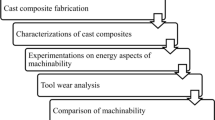Abstract
The alumina based ceramic cutting tools are used to machine glass fibre reinforced plastic (GFRP) composite material and AISI D2 steel. The machining studies were conducted using Ti[C,N] mixed alumina based ceramic cutting tool (CC650) and SiC whisker reinforced alumina based ceramic cutting tool (CC670). Machining process was performed at different cutting speeds at constant feed rate and depth of cut and the flank wear of the cutting tools were measured. From the machining studies, the wear behaviour of the cutting tool are studied and compared with reference to the work material. Very smooth wear land was observed while machining GFRP composite whereas, ridges and groves were observed while machining steel using alumina based ceramic cutting tools. The hard metal chips produced during machining has induced to undergo the severe in changes on machining D2 steel. Based on the flank wear, tool face fibre / matrix chip has prone to maximum wear of 0.4mm compared to machining a metal. On machining AISI D2 steel the machining has reduced one fold (1:2) than the GFRP composite material. In summary, Ti[C,N] mixed alumina cutting tool performance better on machining AISI D2 steel and SiC whisker reinforced alumina cutting tool for machining GFRP composite.
Similar content being viewed by others
References
Adam Khan M, Senthil Kumar A (2011) Machinability of glass fibre reinforced plastic (GFRP) composite using alumina based ceramic cutting tools. J Manuf Process 13(1):67–73
Aslan E, Camuscu N, Birgoren B (2007) Design optimization of cutting parameters when turning hardened AISI 4140 steel (63 HRC) with Al2 O 3 + TiCN mixed ceramic tool. Mater Des 28(5):1618–1622
Xu C H, Feng Y M, Zhanga RB, Zhao SK, Xiao X, Yu GT (2009) Wear behavior of Al2 O 3/Ti(C,N)/SiC new ceramic tool material when machining tool steel and cast iron. J Mater Process Technol 209(10):4633–4637
Senthil Kumar A, Raja Durai A, Sornakumar T (2003) Machinability of hardened steel using alumina based ceramic cutting tools. Int J Refract Metals Hard Mater 21(3-4):109–117
Senthil Kumar A, Raja Durai A, Sornakumar T (2006) The effect of tool wear on tool life of alumina-based ceramic cutting tools while machining hardened martensitic stainless steel. J Mater Process Technol 173(2):151–156
Paulo Davim J, Mata F (2005) A new machinability index in turning fiber reinforced plastics. J Mater Process Technol 170(1–2):436–440
Paulo Davim J, Mata F (2005) Optimisation of surface roughness on turning fibre reinforced plastics (FRP’s) with diamond cutting tools. Int J Adv Manuf Technol 26(4):319–323
Lee E S (2001) Precision machining of glass fibre reinforced plastics with respect to tool characteristics. Int J Adv Manuf Technol 17(11):791–798
Santhanakrishnan G, Krishnamurthy R, Malhotra S K (1989) High speed tool wear studies in machining of glass fibre reinforced plastic. Wear 132(2):327–336
Braghnini A Jr, Coelho R T (2001) An investigation of the wear mechanisms of polycrystalline cubic boron nitride (PCBN) tools when end milling hardened steels at low/medium cutting speeds. Int J Adv Manuf Technol 17 (4):244–257
Grzesik W (2008) Influence of tool wear on surface roughness in hard turning using differently shaped ceramic tools. Wear 265(3-4):327–335
Thirumalai Kumaran S, Uthayakumar M, Adam Slota S, Aravindan JZ (2016) Machining behavior of AA6351–SiC–B4C hybrid composites fabricated by stir casting method. Part Sci Technol 34(5):586–592
Sahin Y (2009) Comparison of tool life between ceramic and cubic boron nitride (CBN) cutting tools when machining hardened steels. J Mater Process Technol 209(7):3478–3489
Paulo Davim J, Figueira L (2007) Machinability evaluation in hard turning of cold work tool steel (D2) with ceramic tools using statistical techniques. Mater Des 28(4):1186–1191
Komanduri R (1997) Machining of fibre reinforced composite. Mach Sci Technol 1(1):113–152
Paulo Davim J, Silva LR, Festas A, Abrão A M (2009) Machinability study on precision turning of PA66 polyamide with and without glass fiber reinforcing. Mater Des 30(2):228–234
Thirumalai Kumaran S, Ko TJ, Kurniawan R, Li C, Uthayakumar M (2017) ANFIS modeling of surface roughness in abrasive waterjet machining of carbon fiber reinforced plastics. J Mech Sci Technol 31(8):3949–3954
Venu Gopala Roa G, Mahajan P, Bhatnagar N (2007) Machining of UD-GFRP composites chip formation mechanism. Compos Scie Technol 67(11-12):2271–2281
Rahman M, Ramakrishna S, Prakash J R S, Tan D C G (1999) Machinability study of carbon fibre reinforced composite. J Mater Process Technol 89-90:292–297
Ozel T, Karpat Y, Figueira L, Paulo Davim J (2007) Modelling of surface finish and tool flank wear in turning of AISI D2 steel with ceramic wiper inserts. J Mater Process Technol 189(1–3):192–198
Author information
Authors and Affiliations
Corresponding author
Rights and permissions
About this article
Cite this article
Khan, M., Kumar, A., Kumaran, S. et al. Effect of Tool Wear on Machining GFRP and AISI D2 Steel Using Alumina Based Ceramic Cutting Tools. Silicon 11, 153–158 (2019). https://doi.org/10.1007/s12633-018-9839-7
Received:
Accepted:
Published:
Issue Date:
DOI: https://doi.org/10.1007/s12633-018-9839-7




